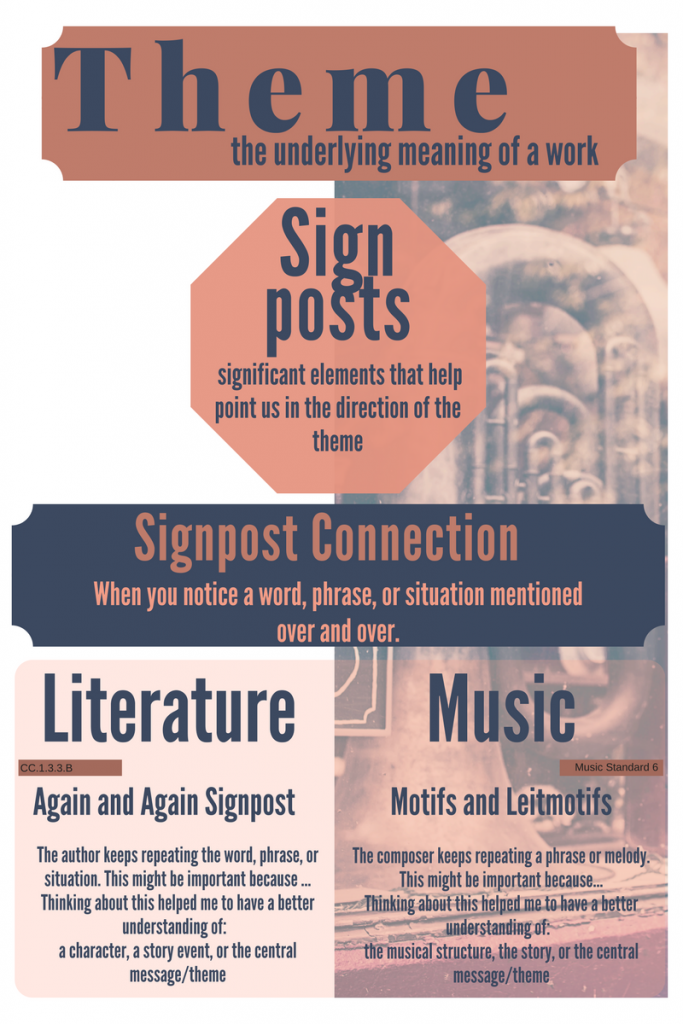Signposts, Using Notice and Notes for Literature and the Arts
4 Min Read • Arts Integration
One of the best ways to help students find the central message, or theme, of a text, is to use Notice and Note strategies for Literature and the Arts. These are from a must-read book for reading instruction, Notice and Note: Strategies for Close Reading by Kylene Beers and Robert Probst. Beers and Probst recommend that we guide students to look for certain “Signposts“, or significant events while reading. When we notice these Signposts, we should stop and note them. Noticing these Signposts helps us learn more about the characters, setting, and/or central message/theme of a text.
The Signposts, Notice, and Notes for Literature and the Arts
- Again and Again
- Contrast and Contradictions
- Words of the Wiser
- A-Ha Moment
- Memory Moment
- Tough Questions
While these signposts are designed for literary works, there are many that apply to the Arts. My “A-ha” arts connection was the “Again and Again” Signpost. This is when a word, phrase, picture, or situation is repeated, making the reader wonder about its importance. In music, this is called a motif. Composers, artists, choreographers, and playwrights use this element when creating their music, art, dance, or plays. Helping students to see how this applies across disciplines can give them a better understanding, allowing them to comprehend more than just literary texts.
Teaching the “Again and Again” Signpost with Text
I saw a fabulous lesson on Signposts recently that was designed by an instructional coach in my district. After students knew the idea of the Again and Again Signpost, she had students watch the Pixar short Boundin’. Students watched for the “Again and Again” that occurred and then discussed their findings. They were encouraged to use sentence starters such as:
- The author keeps repeating the (word, phrase, picture, situation) __________________ because …
- This might be important because …
- Thinking about this signpost helped me to have a better understanding of:
- a character
- a story event
- the central message/theme
Then, students participated in a guided close read of the text Ish by Peter H. Reynolds. As they read, they annotated the text, underlining any Signposts that they noticed and noting their thoughts about what they underlined. The strategy “two fingers and an elbow” allowed students to check for their annotations. They placed a finger on the underlined text, another finger on their thoughts about that underlined text, and an elbow on the Signpost labeled “AA” in this example.
Resources for Teaching Again and Again
- It is easiest to teach this Signpost with picture books and movie shorts. Then, students should look for them (and note them) as they are reading longer novels.
- Picture Books for teaching the Again and Again Signposts
Teaching the “Again and Again” Signpost with Music
When we notice an “Again and Again” moment in music, it is typically a musical phrase that is repeated throughout a piece. Think of Beethoven’s 5th Symphony (listen to the first ten seconds here). This famous phrase is repeated many times throughout the composition, giving the piece its identity. After listening, students could even annotate the melody on sheet music in a very similar fashion to the annotations we made in the book Ish, underlining the notes that are the “Again and Again” phrase, jotting down thoughts, and labeling them as the motive. The two finger and an elbow strategy would be a great check for annotation here as well.
Resources for Teaching Motif
- Find a detailed lesson plan.
- A lesson plan based on Beethoven.
- Beethoven’s 5th Symphony
- Beethoven’s Symphony No. 7, second movement
- Waltz in A flat by Brahms, Op.39 No. 15
Combining Text, Music, and Film with Leitmotifs
Once students understand the idea of the Again and Again Signposts in literature and the arts, take it a step further by connecting these to film. A leitmotif is a recurring musical phrase associated with a specific character, place, or emotion. Typically, when we watch a movie, we don’t realize how much these musical clues help support the plot and character development so that we can better comprehend the story. Noticing the leitmotif for a character can lead to discussions about the composer’s choices. Why did the composer choose that instrument/rhythm/key/mood to represent the character? How does the music help us understand the character better?
Resources for Teaching Leitmotifs
- Peter and the Wolf lesson plan
- Many movies, such as The Lion King, The Little Mermaid, Toy Story, How to Train Your Dragon, Harry Potter
Extending the Learning
Depending on the level of students and amount of time, a fantastic project-based culmination for this learning is to have students write their own narrative story. Students writers can craft “Again and Again” moments into their text, modeling some of the mentor texts they have examined. Students could create musical clips using Garageband or Soundtrap, or even use sound effects in iMovie, to use as leitmotifs. Using an app like iBooks Author or other story creation tool, students could tell their story, dragging the appropriate sound to the place in the story they would like it to play.
Looking at this idea visually can help students (and teachers) see the connection between literary elements and musical elements. This infographic may be helpful to post during your instruction. Have made connections between Signposts for Literature and the Arts? Share them in the comments below!




